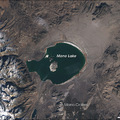
...along the western edge of the Great Basin—one of North America’s four largest deserts—sits Mono Lake. This salty remnant of a wetter era resides in a landscape of geologically young and potentially active volcanoes...
"This solemn, silent, sail-less sea—this lonely tenant of the loneliest spot on earth—is little graced with the picturesque," wrote Mark Twain, who spent several years in the region during the mid-1860's. "It is an unpretending expanse of grayish water, about a hundred miles in circumference, with two islands in its centre, mere upheavals of rent and scorched and blistered lava, snowed over with gray banks and drifts of pumice-stone and ashes, the winding sheet of the dead volcano, whose vast crater the lake has seized upon and occupied."

"Lake Mono," illustration from Mark Twain's Roughing It, 1872"This is the most remarkable lake I have ever seen," wrote William Brewer, of the Whitney Survey, after washing his dirty clothes in it during the summer of 1863. "It lies in a basin at the height of 6,800 feet above the sea. Like the Dead Sea, it is without an outlet. The streams running into it all evaporate from the surface, so of course it is very salt—not common salt. There are hot springs in it, which feed it with peculiar mineral salts. It is said that it contains borax, also boracic acid, in addition to the materials generally found in saline lakes. The waters are very clear and very heavy—they have a nauseous taste. When still, it looks like oil, it is so thick, and it is not easily disturbed. Although nearly twenty miles long it is often so smooth that the opposite mountains are mirrored in it as in a glass. The water feels slippery to the touch and will wash grease from the hands, even when cold, more readily than common hot water and soap. I washed some woolens in it, and it was quicker and easier than any “suds” I ever saw. It washed our silk handkerchiefs, giving them luster as if new."
NASA's Earth Observatory.
Full-res image (3 mb)... note the snow-capped peaks along the eastern edge of Yosemite National Park, note the Glass Mountains to the southwest, and Mammoth Mountain Ski Area due south, at the bottom of the image.